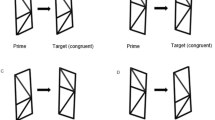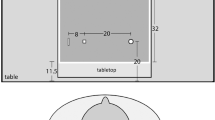Abstract
The human vision system appears to divide into two streams: a ventral stream from V1 to the inferior temporal cortex processing ‘vision for perception’, and a dorsal stream from V1 to the posterior parietal cortex processing ‘vision for action’. Among other characteristics, it has been suggested that dorsal processing is effortless, unconscious, and not bearing on central cognitive resources implicated in ventral processing. The present study shows that a typical dorsal task (i.e., grasping an object) is subject to a classical indicator of capacity limitations in dual-task situations, the psychological refractory period (PRP) effect. In particular, response times to task 2 (the grasping task) increased the more the two tasks overlapped in time, i.e., the shorter the time interval between the stimuli of the two tasks was. As is also common in PRP experiments, response times to task 1 were largely unaffected by this variation. The PRP effect was obtained despite careful control of strategic response deferment, and peripheral overlap of response modalities that may have artificially created performance costs in previous studies. Altogether, the present results show that dorsal processing is subject to the same capacity limitations that can almost universally be found with simple cognitive tasks.





Similar content being viewed by others
References
Aglioti S, DeSouza JFX, Goodale MA (1995) Size-contrast illusions deceive the eye but not the hand. Curr Biol 5:679–685
Franz VH, Gegenfurtner KR (2008) Grasping visual illusions: consistent data and no dissociation. Cogn Neuropsychol 25:920–950
Ganel T, Goodale MA (2003) Visual control of action but not perception requires analytical processing of object shape. Nature 426:664–667
Garner WR (1974) The processing of information and structure. Erlbaum, Potomac
Garner WR (1978) Selective attention to attributes and to stimuli. J Exp Psychol Gen 107:287–308
Goodale MA (2008) Action without perception in human vision. Cogn Neuropsychol 25:891–919
Goodale MA, Milner AD (1992) Separate pathways for perception and action. Trends Neurosci 15:20–25
Goodale MA, Milner AD (2004) Plans for action. Behav Brain Sci 27:37–40
Hazeltine E, Ruthruff E, Remington RW (2006) The role of input and output modality pairings in dual-task performance: evidence for content-dependent central interference. Cogn Psychol 52:291–345
Heuer H (1995) Models for response-response compatibility: the effects of the relation between responses in a choice task. Acta Psychol 90:315–332
James TW, Culham J, Humphrey GK, Milner AD, Goodale MA (2003) Ventral occipital lesions impair object recognition but not object-directed grasping: a fMRI study. Brain 126:2463–2475
Jeannerod M, Jacob P (2005) Visual cognition: a new look at the two-visual systems model. Neuropsychologia 43:301–312
Kunde W, Landgraf F, Paelecke M, Kiesel A (2007) Dorsal and ventral processing under dual-task conditions. Psychol Sci 18:100–104
Lee T-Y, Hsieh S (2009) The limits of attention for visual perception and action in aging. Aging Neuropsychol Cogn 16:311–329
Lien M-C, Ruthruff E, Johnston JC (2006) Attentional limitations in doing two tasks at once. The search for exceptions. Curr Dir Psychol Sci 15:89–93
Liu G, Chua R, Enns JT (2008) Attention for perception and action: task interference for action planning, but not for online control. Exp Brain Res 185:709–717
Miller J, Ulrich R (2008) Bimanual response grouping in dual-task paradigms. Q J Exp Psychol 61:999–1019
Miller J, Ulrich R, Rolke B (2009) On the optimality of serial and parallel processing in the psychological refractory period paradigm: effects of the distribution of stimulus onset asychronies. Cogn Psychol 58:273–310
Milner AD, Goodale MA (2006) The visual brain in action, 2nd edn. University Press, Oxford
Navon D (1984) Resources—a theoretical soup stone? Psychol Rev 91:216–234
Norman J (2002) Two visual systems and two theories of perception: an attempt to reconcile the constructivist and ecological approaches. Behav Brain Sci 25:73–144
Pashler H (1990) Do response modality effects support multiprocessor models of divided attention? J Exp Psychol Hum Percept Perform 16:826–842
Pashler H (1994) Dual-task interference in simple tasks: data and theory. Psychol Bull 116:220–244
Pashler H, Johnston JC (1998) Attentional limitations in dual-task performance. In: Pashler H (ed) Attention. Psychology Press, Hove, pp 155–189
Pashler H, Carrier M, Hoffman J (1993) Saccadic eye movements and dual-task interference. Q J Exp Psychol 46:51–82
Perenin MT, Vighetto A (1988) Optic ataxia: a specific disruption in visuomotor mechanisms. I. Different aspects of the deficit in reaching for objects. Brain 111:643–674
Pisella L, Binkofski F, Lasek K, Toni I, Rossetti Y (2006) No double-dissociation between optic ataxia and visual agnosia: multiple sub-stream for multiple visuo-manual integrations. Neuropsychologia 44:2734–2748
Posner M (1964) Information reduction in the analysis of sequential tasks. Psychol Rev 71:491–504
Ruthruff E, Miller J, Lachmann T (1995) Does mental rotation require central mechanisms? J Exp Psychol Hum Percept Perform 21:552–570
Ruthruff E, Johnston JC, van Selst M (2001) Why practice reduces dual-task interference. J Exp Psychol Hum Percept Perform 27:3–21
Shaffer LH (1975) Multiple attention in continuous verbal tasks. In: Rabbitt PMA, Dornic S (eds) Attention and performance V. Academic Press, San Diego, pp 157–167
Singhal A, Culham JC, Chinellato E, Goodale MA (2007) Dual-task interference is greater in delayed grasping than in visually guided grasping. J Vision 7:1–12
Tombu M, Jolicoeur P (2003) A central capacity sharing model of dual-task performance. J Exp Psychol Hum Percept Perform 29:3–18
Ungerleider LG, Mishkin M (1982) Two cortical visual systems. In: Ingle DJ, Goodale MA, Mansfield RJW (eds) Analysis of visual behavior. MIT Press, Cambridge, pp 549–586
Welford AT (1952) The ‘psychological refractory period’ and the timing of high-speed performance—a review and a theory. Br J Psychol 43:2–19
Wickens CD (1980) The structure of attentional resources. In: Nickerson R (ed) Attention and performance, vol 8. Erlbaum, Hillsdale, pp 239–257
Wickens CD (1984) Processing resources in attention. In: Parasuraman R, Davies DR (eds) Varieties of attention. Academic Press, Orlando, pp 63–102
Author information
Authors and Affiliations
Corresponding author
Rights and permissions
About this article
Cite this article
Janczyk, M., Kunde, W. Does dorsal processing require central capacity? More evidence from the PRP paradigm. Exp Brain Res 203, 89–100 (2010). https://doi.org/10.1007/s00221-010-2211-9
Received:
Accepted:
Published:
Issue Date:
DOI: https://doi.org/10.1007/s00221-010-2211-9




